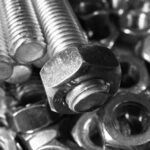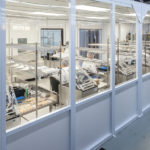~ Article courtesy of UC Components

Electropolishing removes a thin layer of surface material, including any surface impurities or contaminants, which can enhance the corrosion resistance of the fasteners. It’s particularly useful for fasteners used in harsh or corrosive environments.
Fasteners installed in any assembly or piece of equipment must be long-lasting and able to withstand repeated use. Coatings and platings are often used to ensure fastener longevity, preventing galling in metal components and improving corrosion resistance. They’re also often used for aesthetic reasons.
Where coatings add a powder or chemical layer to the surface of a fastener, plating typically fuses new material to the original fastener material. However, there is another option that works to remove surface materials, ensuring several key advantages.
Electropolishing is an electrochemical finishing process that removes a thin layer of material from a metal part, such as stainless steel or similar alloys. The process leaves a smooth, clean surface. It also reduces particulate generation, enhances corrosion resistance, and provides cosmetic improvements — all of which can maximize a fastener’s longevity and save costs.
Electropolished fasteners are used extensively in industries such as semiconductors, medical, marine, energy, clean room applications, food and beverage processing, and others.
How is electropolishing performed?
The electropolishing process carefully dissolves unwanted surface metals. It leaves behind a component’s true base metal(s), significantly reducing surface burrs, chips, and peeling. This is particularly important for threaded parts.
Electropolishing also greatly reduces surface particulate, reduces outgassing and corrosion, and imparts a bright, chrome-like finish.
The process is as follows:
- The fastener is immersed in an electropolish solution and then subjected to direct current (DC).
- The fastener is made anodic (+), and a metal cathode (-) is used.
- The current flows from the anode (which becomes polarized), allowing metal ions to diffuse through the film to the cathode while removing metal at a controlled rate. The amount of metal removed depends on the specific bath, temperature, current density, and the particular alloy being electropolished.
Five key advantages
Electropolishing a fastener offers five major benefits.
1. Promotes easy cleaning. Electropolishing greatly improves a fastener’s micro-finish, which makes the part easy to clean. An electropolished fastener ensures a reduction in bacteria and debris buildup on the surface, making it easier to sterilize and far more hygienic than a non-electropolished fastener. This is particularly important in clean-critical industries such as medical or food & beverage manufacturing.
2. Increases resistance to corrosion. Typically, corrosion begins on or near the surface of fasteners because of surface contaminants. This means that simply handling a fastener for installation leads to the degradation of its surface properties. Other sources of surface contaminants include grease, dirt, moisture, iron, and metal particles from cutting, machining. or welding operations, as well as other fabricating processes.

Electropolished vented screws. Electropolishing effectively removes surface contaminants and microscopic imperfections, making it ideal for fasteners used in industries where cleanliness and hygiene are crucial.
Electropolishing significantly improves the near-surface chemistry of fasteners, removing oxidation and providing superior corrosion resistance.
3. Deburrs the metal. Deburring is critical in certain industries, such as food or aerospace, where small flecks of metal flaking off of a fastener could be a health hazard or cause critical failure.
The electroplating process simultaneously polishes and deburrs the fastener’s surface. This is a non-mechanical process, so there’s no risk of distortion to the fastener. Nor does its material hardness change the processing time or overall cost.
This process is electrochemical and is directly proportionate to the current density. Deburring also limits the likelihood of fastener galling. Galling is a form of wear that can lead to metal adhesion and seizing.
4. Improves the overall surface finish. Some conventional mechanical finishing processes can bend, stress, or fracture a fastener. The electropolishing process only removes enough surface material to form a smooth, even surface. Electropolishing efficiently achieves a uniform, clean appearance and a smooth surface texture that helps fasteners function better over time in any given application.
5. Makes it more attractive. The lustrous finish from electropolishing is aesthetically pleasing and microscopically smooth. The finish is shiny and chrome-like without costly mechanical polishing or buffing.









Tell Us What You Think!